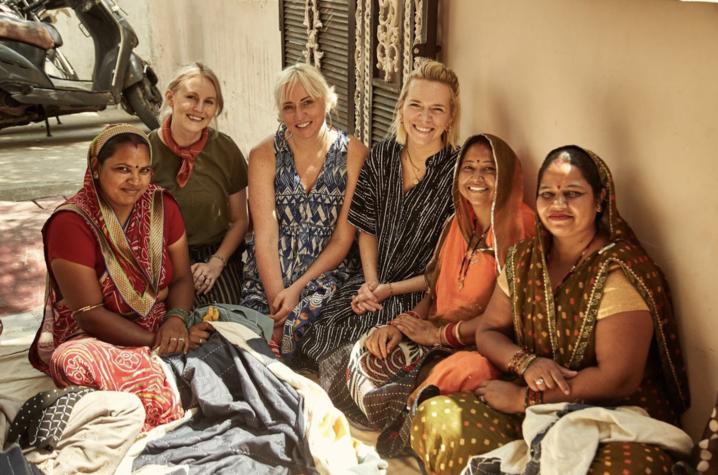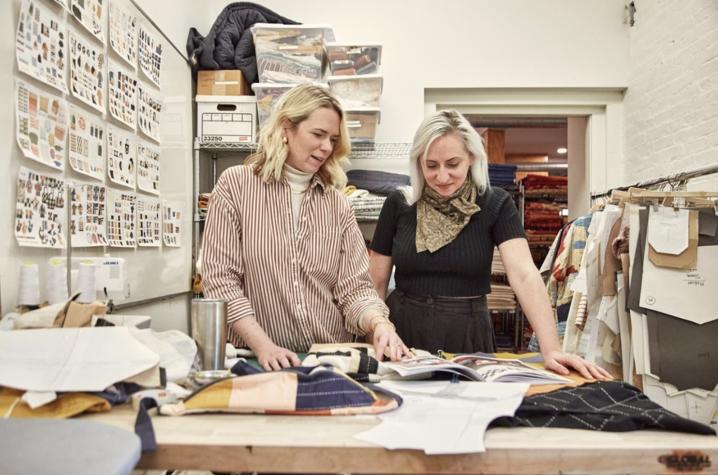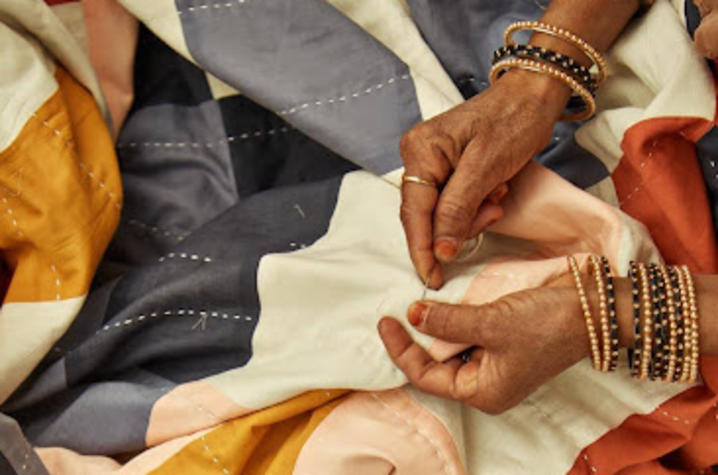Sisters, UK alumnae transform lives through design, social entrepreneurship
LEXINGTON, Ky. (July 29, 2024) — This article is featured in the Summer 2024 edition of Kentucky Alumni magazine.
***
A graduate class trip to India produces good in the world
There are a lot of ways to measure the success of Anchal, the nonprofit social enterprise founded by two University of Kentucky design alumnae.
Revenues have grown more than tenfold since they began in 2010, to $900,000 in 2022. Anchal has twice collaborated with the Guggenheim Museum and claims Anthropologie and Urban Outfitters as clients. Last year Anchal moved into a new space in Louisville with a storefront retail shop and workspaces, a photography studio, meeting room and space to fulfill online orders in the back.
A workforce of eight has grown to almost 300. The Clines sisters, Colleen (a 2008 landscape architecture graduate from the Martin-Gatton College of Agriculture, Food and Environment) and Maggie (a 2011 architecture graduate from the College of Design), founded Anchal and have gone from keeping things afloat by living at home and working other jobs for three years to earning decent livings running Anchal full-time (and more).
None of that, though, is quite the point for the sisters.
They are proud they’re close to achieving a million dollars in sales.
"As a woman-run business that would be a very exciting milestone to reach,” said Colleen, Anchal’s CEO.
But the biggest measure of success, the “biggest motivator, the reason we do what we do,” said Maggie, who is COO and creative director, is “knowing how much of an impact one quilt sale can have on a woman’s life and her family’s life.”
That’s what they had in mind back in 2010 after Colleen had made a trip to India with a class from graduate school. There she saw women who had worked in the sex trade who struggled to find a way to give their children better lives. Partnering with a local nongovernmental organizations they talked about the lack of economic opportunities for women and learned about the local kantha stitching tradition used in quilting.
An idea began to form. Why not use one to address the other?
Back in the U.S., Colleen and classmates raised $400 for a sewing machine, training and materials for artisans, and to pay them for their work. When the first quilts — pieced together from vintage saris — arrived, Maggie helped her sister sell them. They had a vision of combining their shared passion for design with traditional Indian textiles and techniques to create opportunities for women who had none.
“Naively,” Colleen said, the sisters thought “let’s make this into a business.” Maggie added, “we had no idea what we were doing.”
It might seem like some other degree – business, marketing? – could have prepared them better for their enterprise but the sisters think their training has served them well.
“The basis of both of our educations at UK and in design school is creative problem solving,” Colleen said. “Regardless of what we don’t know, I think we felt empowered to figure it out in a creative way.”
Plus, they learned how to work hard. They “weren’t easy majors,” Maggie said.
“We came out of school knowing how hard you have to push to get something that you’re proud of. We weren’t afraid of that.”
They also learned how to market their ideas through presenting projects to professors, guest critics and peers.
“You have to defend your work and learn how to be confident about what you’re doing,” Maggie said. “And sell your ideas,” Colleen added.
So, when it came to renting a booth at trade shows in New York — critical exposure for a Kentucky-based company — they were ready to meet hundreds of buyers and show them what Anchal can do. Also, with a small space costing as much as $10,000 for three days at a show, design skills were critical to organizing their displays for maximum impact.
The first Anchal collaboration with the Guggenheim Museum was to create clothing and quilts for the museum’s store to compliment a show of the work of Swedish painter Hilma af Klint.
“The simplicity and shapes of the quilts and jackets and totes, etc. were a beautiful compliment to the colors and scale of Hilma’s works,” said Kristin Rae, general manager of the Guggenheim Store.
They didn’t try to compete with Hilma, yet were clearly inspired by her works. When a few years later the Guggenheim mounted a large exhibition of the American painter Alex Katz, they turned again to Anchal.
“They were tasked to find the fine line to create something of their own but not entirely,” Rae said. When curators asked for design changes, “they pivoted beautifully. More the reason to love them,” she added.
At UK, design professors see a direct line between their education and their work.
“I mention Anchal all the time to my students as a great example of entrepreneurship, doing something with your design degree as well as doing some good in the world,” said Anne Filson, an associate professor in the UK School of Architecture.
Maggie worked with Filson as a research assistant after graduation. She is “super talented at drawing,” Filson said, and has “the ability to design in different media and at different scales.”
The quilts were an example of that ability to translate skills across materials. Filson said some of the early quilt designs Maggie shared with her were sketched, “almost the way you would draft the floor plan of a building.”
Ned Crankshaw, who is now dean of the College of Design, taught Colleen as an undergraduate.
“She was a really great designer,” he said, "with a persistent social conscience. As the classes discussed design projects Colleen always asked, 'what is it doing, what’s the point of this?'"
Like Filson, he sees the sisters’ work as a credit to the programs at UK.
“We are extremely proud of her,” he said. When talking about “who were some of our really great graduates, Colleen is always on that list.”
Both Filson and Crankshaw are happy Anchal customers.
“We have Anchal everything,” Filson said, and every Mother’s Day she orders Anchal for her mother and sister-in-law.
Crankshaw’s home is also full of Anchal products. Recently an Anchal heart hanging on the wall caught his granddaughter’s eye. “Wow, who made this,” she asked in amazement.
Another group of people who are proud of their connection to Colleen and Maggie are the artisans who sew the Anchal creations, said Shefali Modi who oversees the program in Jaipur, India. On visits to India, the sisters are often photographed with their artisans, sometimes in the workshop, sometimes in their homes, where many of them work.
“They visit their houses; that means a lot,” Modi said. And a photo with the Clines is a prized possession. “Proudly, they show it to everyone.”
Modi has worked in the corporate world of textile production in India for over 20 years, the last five or so with Anchal.
“There’s a big difference,” between the commercial standard and what Anchal offers the women who work with them, she said. “There is so much respect,” and “they’re paid well.”
About 25 women are employed full-time in the workshop. Another 180 or more women do piecework from home, either because they have small children or husbands or in-laws that don’t want them working outside the home.
Each artisan has her own account and “they know clearly how much they are getting,” for the work they produce, Modi said, “which is not so common here.”
Each Anchal product is signed by the artisan who made it. Modi says that for women who are sometimes illiterate and often have hardly traveled beyond where they were born, it is a point of pride knowing the pieces they made are going around the world “and with their name and signature.”
As a nonprofit, Anchal offers more than just pay. Anchal has employee workshops on everything from quality control to stress management and financial planning, annual eye camps to provide new glasses, field trips and even chai tea breaks.
The women who have worked for Anchal for over a decade have grown along with the company. They start off with simple pieces and progress to more complex and highly paid work.
For many, their earnings initially paid for basics like housing and fresh food, Maggie said. “And then we’ve watched their children go to college, the first generation, they’re buying new homes, scooters and water filters.”
Now, some are even buying jewelry for themselves. Colleen sees that as wonderful landmark: “I just thought, ‘whoa, that’s so cool, it’s not about the basics anymore.’”
Neither sister knew much about sewing when they decided to create a company that makes sewn goods. But Maggie learned how (she’s “taken it to the next level,” her sister says) and so she designs and then makes samples of new products, drawing the details on the CAD software system she learned in architecture school to translate the process to the women in India.
While they started with quilts, Maggie said they knew that in order to grow “we can’t keep selling one product for eternity.”
Things took off when she designed the first pouch and the artisans learned how to sew in zippers. “It revolutionized the business.”
From a few quilts in 2010, Anchal has expanded to produce more than 740 different stock keeping units, or SKUs. That number will expand this fall when Anchal’s first line of baby products comes on the market.
That growth means more opportunities and better lives for the women who first moved Colleen and Maggie to start this venture.
A recent show about Anchal’s work at the Kentucky Museum of Arts and Crafts, featuring the work of photographer Clay Cook (who is married to Colleen but that’s another, although related, story), included portraits of artisans accompanied by recordings of their accounts of their lives.
“I remember my life with a great deal of pain,” one woman says, recounting a difficult family life made worse when she married. Eventually, though, she joined Anchal and “it was the best thing that ever happened to me.” Now, she says, she works hard “to make sure my children do not face the difficulties I have faced in life.”
From all this she has learned “there are good and bad people in this world and, after spending most of my life with bad people, I have finally found good people.”
Visit anchalproject.org to see more photos and learn more about the products for sale.
As the state’s flagship, land-grant institution, the University of Kentucky exists to advance the Commonwealth. We do that by preparing the next generation of leaders — placing students at the heart of everything we do — and transforming the lives of Kentuckians through education, research and creative work, service and health care. We pride ourselves on being a catalyst for breakthroughs and a force for healing, a place where ingenuity unfolds. It's all made possible by our people — visionaries, disruptors and pioneers — who make up 200 academic programs, a $476.5 million research and development enterprise and a world-class medical center, all on one campus.







